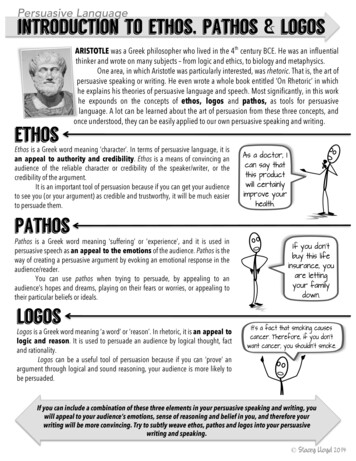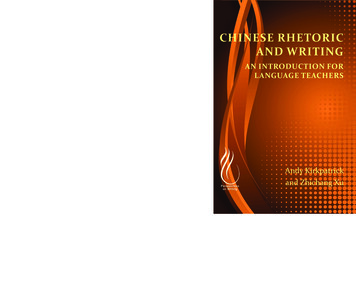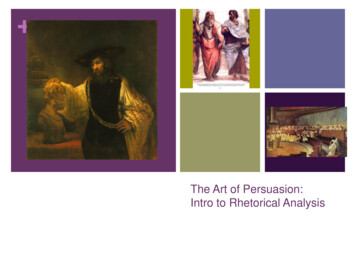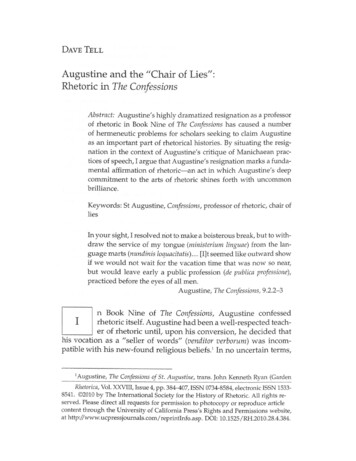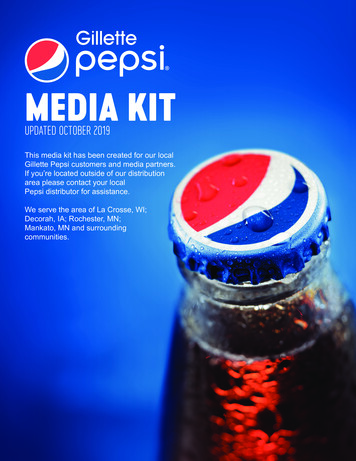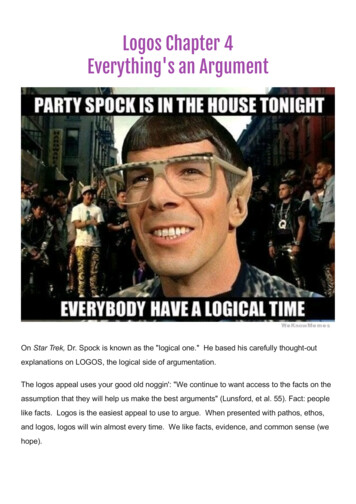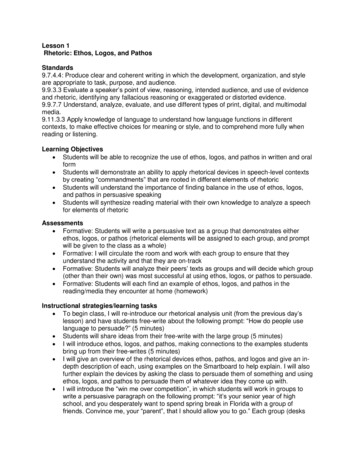
Transcription
Lesson 1Rhetoric: Ethos, Logos, and PathosStandards9.7.4.4: Produce clear and coherent writing in which the development, organization, and styleare appropriate to task, purpose, and audience.9.9.3.3 Evaluate a speaker’s point of view, reasoning, intended audience, and use of evidenceand rhetoric, identifying any fallacious reasoning or exaggerated or distorted evidence.9.9.7.7 Understand, analyze, evaluate, and use different types of print, digital, and multimodalmedia.9.11.3.3 Apply knowledge of language to understand how language functions in differentcontexts, to make effective choices for meaning or style, and to comprehend more fully whenreading or listening.Learning Objectives Students will be able to recognize the use of ethos, logos, and pathos in written and oralform Students will demonstrate an ability to apply rhetorical devices in speech-level contextsby creating “commandments” that are rooted in different elements of rhetoric Students will understand the importance of finding balance in the use of ethos, logos,and pathos in persuasive speaking Students will synthesize reading material with their own knowledge to analyze a speechfor elements of rhetoricAssessments Formative: Students will write a persuasive text as a group that demonstrates eitherethos, logos, or pathos (rhetorical elements will be assigned to each group, and promptwill be given to the class as a whole) Formative: I will circulate the room and work with each group to ensure that theyunderstand the activity and that they are on-track Formative: Students will analyze their peers’ texts as groups and will decide which group(other than their own) was most successful at using ethos, logos, or pathos to persuade. Formative: Students will each find an example of ethos, logos, and pathos in thereading/media they encounter at home (homework)Instructional strategies/learning tasks To begin class, I will re-introduce our rhetorical analysis unit (from the previous day’slesson) and have students free-write about the following prompt: “How do people uselanguage to persuade?” (5 minutes) Students will share ideas from their free-write with the large group (5 minutes) I will introduce ethos, logos, and pathos, making connections to the examples studentsbring up from their free-writes (5 minutes) I will give an overview of the rhetorical devices ethos, pathos, and logos and give an indepth description of each, using examples on the Smartboard to help explain. I will alsofurther explain the devices by asking the class to persuade them of something and usingethos, logos, and pathos to persuade them of whatever idea they come up with. I will introduce the “win me over competition”, in which students will work in groups towrite a persuasive paragraph on the following prompt: “it’s your senior year of highschool, and you desperately want to spend spring break in Florida with a group offriends. Convince me, your “parent”, that I should allow you to go.” Each group (desks
are situated in “pods” of 4-5 students each) will be given a rhetorical device (ethos,logos, or pathos) to focus on while writing their paragraph. They will have 10 minutes tobrainstorm and come up with a convincing argument that fits with their assignedrhetorical device. I’ll model this process on the board briefly. (15 minutes)A “spokesperson” from each group will read their paragraph to the class, and studentswill take notes on each group’s paragraph. These notes will include (a) which rhetoricaldevice is being used and (b) individual words/sentences that utilize the device (10minutes)Each group will vote on which paragraph “won me over”—which paragraph does thebest job of using ethos, logos, or pathos to convince me that they should be allowed togo on spring break vacation. (5 minutes)Homework prompt: “Find a piece of “text” (advertisement, article, news clip, cereal box,etc.) that displays either ethos, logos, or pathos, tonight at home and bring it to classtomorrow! Along with the text, write a paragraph that explains why you think it’s a goodexample of ethos, logos, or pathos. If it’s in a medium that can’t be brought to class,write a description of the text in your writer’s notebook.”Instructional resources/materials Smartboard projected slides (prompts, instructions, etc.)
Lesson 1 slides:
Lesson 1 Assessment:
Lesson 2TED commandments/Pod commandmentsStandards9.9.3.3 Evaluate a speaker’s point of view, reasoning, intended audience, and use of evidenceand rhetoric, identifying any fallacious reasoning or exaggerated or distorted evidence.9.9.7.7 Understand, analyze, evaluate, and use different types of print, digital, and multimodalmedia.9.11.3.3 Apply knowledge of language to understand how language functions in differentcontexts, to make effective choices for meaning or style, and to comprehend more fully whenreading or listening.Learning Objectives Students will analyze lists of rhetorical devices, looking for ethos, logos, and pathosthroughout Students will form lists of the elements they feel are necessary for strong, persuasivecommunication skills Students will analyze a persuasive speech, looking for rhetorical devices such as ethos,logos, pathos, and for signs of engaging, persuasive communicationAssessments Formative: students will create amendments to the “TED Commandments”: at least 5elements of speech they would add/subtract from the TED commandments. They will berequired to use ethos, logos, and pathos in their amendments. Formative: I will circulate the room and work with each group to ensure that theyunderstand the activity and that they are on-track Formative: students will analyze a short TED talk, looking for (a) use of the “TEDcommandments” and (b) use of items from their “Pod commandments”. This will be awritten analysis, and they will turn it in as an “exit slip” for the day.Instructional strategies/learning tasks Students will share the examples of ethos, logos, and pathos that they found forhomework the previous night in their “pods”. After sharing in small groups, I’ll ask for afew examples to share with the group. (5 minutes) I’ll bridge into today’s lesson by explaining that though ethos, logos, and pathos mayseem like broad categories, they can be broken down into specific communication skills. I’ll introduce TED talks and hand out printed copies of the “TED commandments”—theset of rules that speakers at TED conferences are given in order to help them presentengaging, persuasive speeches. Each pod will read the commandments together and decide whether eachcommandment falls under the category of ethos, logos, pathos. Next, we’ll read througheach commandment out loud to confirm that each group made the same connections toethos, logos, and pathos. (10 minutes) We’ll have a discussion about which ends of the “rhetorical triangle” (ethos, logos, andpathos) are missing in the TED commandments (which shouldn’t be difficult, as most ofthe commandments gear solely toward the pathos end of the triangle). We’ll discuss theimportance of being able to use all 3 rhetorical techniques in persuasive speaking.
Each pod will create a list of 5 commandments that should be added to the list of “TEDcommandments”. They will be required to add at least 1 ethos commandment, 1 logoscommandment, and one pathos commandment. (15 minutes)Each pod will share their additional commandments with the class, explaining how eachcommandment connects to either ethos, logos, or pathos. (5 minutes)I’ll prepare students to watch a TED persuasive speech by explaining that when webreak ethos, logos, and pathos down into more specific techniques, it is easier to pickout and recognize the rhetoric that speakers often use.Students will watch a TED talk, an 8 minute speech by Adora Svitak, entitled “Whatadults can learn from kids”. As they watch, they will take notes on the techniques thatAdora Svitak uses as she speaks by picking out examples of “TED commandments”, oftheir additional commandments, and of ethos, logos, and pathos in general. They willwrite these notes in their writer’s notebooks. (10 minutes)Students will talk in small groups about the rhetorical devices (TED commandments,ethos, logos, and pathos) they noticed in the video, and we’ll end class by sharing theseobservations as a class. (5-10 minutes)Instructional resources/materials Smartboard projected slides List of “TED commandments” (http://www.tedxgundeldingen.com/speakers.html) Poster Paper, markers TED video: Adora Svitak: What adults can learn from kids(http://www.ted.com/talks/adora svitak/transcript#t-93560)
Lesson 2 slides:
Lesson 2 Attachment: TED commandmentsTED Commandments1. Thou shalt not simply trot out thy usual shtick.2. Thou shalt dream a great dream, or show forth a wondrousnew thing, or share something thou hast never sharedbefore.3. Thou shalt reveal thy curiosity and thy passion.4. Thou shalt tell a story.5. Thou shalt freely comment on the utterances of otherspeakers for the sake of blessed connection and exquisitecontroversy.6. Thou shalt not flaunt thine ego. Be thou vulnerable speakof thy failures as well as thy success.7. Thou shalt not sell from the stage neither thy company, thygoods, thy writings, nor thy desperate need for funding, lestthou be cast aside into outer darkness.8. Thou shalt remember all the while: laughter is good.9. Thou shalt not read thy speech.10.Thou shalt not steal the time of them that follow thee.5 amendments:
Lesson 3Standards9.9.3.3 Evaluate a speaker’s point of view, reasoning, intended audience, and use of evidenceand rhetoric, identifying any fallacious reasoning or exaggerated or distorted evidence.9.9.7.7 Understand, analyze, evaluate, and use different types of print, digital, and multimodalmedia.9.11.3.3 Apply knowledge of language to understand how language functions in differentcontexts, to make effective choices for meaning or style, and to comprehend more fully whenreading or listening.Learning Objectives Students will be able to analyze a text for rhetorical devices such as ethos, logos, andpathos, and will infer the intended audience of that text. Students will understand that it is important to consider audience when planning forcommunication, and will understand that the use of rhetorical devices such as ethos,logos, and pathos is extremely dependent on audience.Assessments Formative: students will share their group’s cereal box textual analysis, displaying theirunderstanding of ethos, logos, pathos, their understanding of audience, and at leastsome understanding of how the two elements interact. Formative: I will circulate the room and work with each group to ensure that theyunderstand the activity and that they are on-track Formative: students will write about how audience influences rhetorical choices in theirwriter’s notebooks, which will display their understanding of how these two elementsinteract.Instructional strategies/learning tasks Students will start by free-writing about the following prompt: “what are thecharacteristics of the audience of yesterday’s TED talk?” We’ll briefly review the videofrom yesterday and TED conferences, and they’ll brainstorm about what types ofaudience members might attend a TED talk. (5 minutes) Students will share in small groups the characteristics they came up with, and willdiscuss the following prompt: “How did Adora Svitak cater to this audience in herspeech?” I’ll have students look back in their notes on Adora’s use of rhetoric and makeconnections between the audience and her speaking techniques. (5 minutes) We’ll share examples from small group discussions as a class, and I’ll explain that whenpeople speak persuasively, especially when they have specific intentions with theirspeaking, they think carefully about their audience in framing what and how they willcommunicate. I will bridge into an explanation of the “cereal box text analysis” by framing cerealadvertising as a type of “speech” with specific intentions—to persuade consumers to buytheir cereal. I will then introduce 7 empty cereal boxes (for the 7 groups), each of which Ibelieve has a unique/evident advertising strategy. I’ll explain that each group is going toget a cereal box, and they are going to analyze the box as a “text”, looking for elementsof rhetoric. Once I distribute the boxes, I’ll give students their first task: to look for examples ofethos, logos, and pathos on their box. They will have one scribe who will record their
findings. They will have 10 minutes to find every example of ethos, logos, and pathosthat they can (on the front, back, and sides of their box). (10 minutes)After 10 minutes, I’ll give students their second task: to describe the main characteristicsof the intended “audience” (or consumer) of the box. Their scribe will record thesecharacteristics as well. After they record, they will look through their list of advertisingstrategies and of consumer characteristics and find any strategies that cater to specificcharacteristics (10 minutes).A spokesperson from each group (not the scribe) will then share their box, theirexamples of ethos, logos, and pathos, and the characteristics of their “audience” with theclass. (5 minutes)As a large group, we will discuss which groups had similar audiences and whether or notthe advertising strategies for these similar audiences were also similar. (10 minutes)For homework, students will write in their writer’s notebooks on the following prompt:“How does audience relate to the use of ethos, logos, and pathos? Does audiencematter when deciding which rhetorical devices to use? How so?”Instructional resources/materials Smartboard projected slides 7 cereal boxes
Lesson 3 slides:
Lesson 3 Assessment:
seem like broad categories, they can be broken down into specific communication skills. I'll introduce TED talks and hand out printed copies of the "TED commandments"—the set of rules that speakers at TED conferences are given in order to help them present engaging, persuasive speeches.


